 W
WMythological objects encompass a variety of items found in mythology, legend, folklore, tall tale, fable, religion, spirituality, superstition, paranormal, and pseudoscience from across the world. This list will be organized according to the category of object.
 W
WAn adder stone is a type of stone, usually glassy, with a naturally occurring hole through it. Such stones, which usually consist of flint, have been discovered by archaeologists in both Britain and Egypt. Commonly, they are found in Northern Germany at the coasts of the North and Baltic Seas.
 W
WThe aegis, as stated in the Iliad, is a device carried by Athena and Zeus, variously interpreted as an animal skin or a shield and sometimes featuring the head of a Gorgon. There may be a connection with a deity named Aex or Aix, a daughter of Helios and a nurse of Zeus or alternatively a mistress of Zeus. The aegis of Athena is referred to in several places in The Iliad. "It produced a sound as from a myriad roaring dragons and was borne by Athena in battle ... and among them went bright-eyed Athene, holding the precious aegis which is ageless and immortal: a hundred tassels of pure gold hang fluttering from it, tight-woven each of them, and each the worth of a hundred oxen."
 W
WAkshaya Patra meaning inexhaustible vessel, is an object from the Hindu epic, Mahabharata. It was a wonderful vessel given to Yudhishthira by Lord Surya which held a never-depleting supply of food to the Pandavas every day.
 W
WThe Alatyr in Russian legends and folklore is a sacred stone, the "father to all stones", the navel of the earth, containing sacred letters and endowed with healing properties. Although the name Alatyr appears only in East Slavic sources, the awareness of the existence of such a stone exists in various parts of the Slavdom. It is often mentioned in stories and referred to in love spells as "a mighty force that has no end."
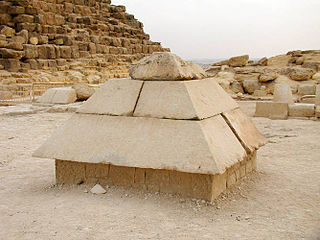 W
WIn the creation myth of the Heliopolitan form of ancient Egyptian religion, Benben was the mound that arose from the primordial waters Nu upon which the creator deity Atum settled. The Benben stone is the top stone of the pyramid. It is also related to the obelisk.
 W
WA bident is a two-pronged implement resembling a pitchfork. In classical mythology, the bident is a weapon associated with Hades (Pluto), the ruler of the underworld.
 W
WThe caduceus is the staff carried by Hermes in Greek mythology and consequently by Hermes Trismegistus in Greco-Egyptian mythology. The same staff was also borne by heralds in general, for example by Iris, the messenger of Hera. It is a short staff entwined by two serpents, sometimes surmounted by wings. In Roman iconography, it was often depicted being carried in the left hand of Mercury, the messenger of the gods.
 W
WCharon's obol is an allusive term for the coin placed in or on the mouth of a dead person before burial. Greek and Latin literary sources specify the coin as an obol, and explain it as a payment or bribe for Charon, the ferryman who conveyed souls across the river that divided the world of the living from the world of the dead. Archaeological examples of these coins, of various denominations in practice, have been called "the most famous grave goods from antiquity."
 W
WCharter Stones date back to ancient times when such stones were granted to individuals or communities in lieu of written charters to signify the granting of land by the crown, feudal overlords or other individuals. They were used to record ownership of land before written documents came into general use.
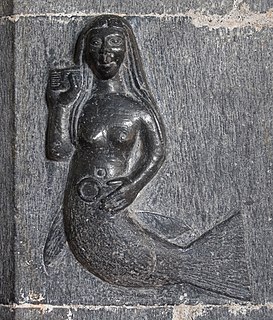 W
WMerrow is a mermaid or merman in Irish folklore. The term is of Hiberno-English origin.
 W
WIn classical antiquity, the cornucopia, from Latin cornu (horn) and copia (abundance), also called the horn of plenty, was a symbol of abundance and nourishment, commonly a large horn-shaped container overflowing with produce, flowers, or nuts.
 W
WThe Corporal of Bolsena dates from a Eucharistic miracle in Bolsena, Italy, in 1263 when a consecrated host allegedly began to bleed onto a corporal, the small cloth upon which the host and chalice rest during the Canon of the Mass. The appearance of blood was seen as a miracle to affirm the Roman Catholic doctrine of transubstantiation, which states that the bread and wine become the Body and Blood of Christ at the moment of consecration during the Mass. Today the Corporal of Bolsena is preserved in a rich reliquary at Orvieto in the cathedral. The reddish spots on the cloth, upon close observation, show the profile of a face similar to those that traditionally represent Jesus Christ. It is said that the miraculous bleeding of the host occurred in the hands of an officiating priest who had doubts about transubstantiation. The "Miracle of Bolsena" is regarded by the Roman Catholic Church as a private revelation, meaning that Catholics are under no obligation to believe it although they may do so freely.
 W
WManannán or Manann, also known as Manannán mac Lir, is a warrior and king of the Otherworld in Irish mythology who is associated with the sea and often interpreted as a sea god, usually as a member of the Tuatha Dé Danann.
 W
WThe Cup of Jamshid is a cup of divination, which in Persian mythology was long possessed by the rulers of ancient Greater Iran. Its name is associated with Jamshid, a mythological figure of Greater Iranian culture and tradition. The cup has also been called Jam-e Jahan nama, Jam-e Jahan Ara, Jam-e Giti nama, and Jam-e Kei-khosrow. The latter refers to Kaei Husravah in the Avesta, and Sushrava in the Vedas.
 W
WThe Fountain of Youth, a mythical spring, allegedly restores the youth of anyone who drinks or bathes in its waters. Tales of such a fountain have been recounted around the world for thousands of years, appearing in the writings of Herodotus, in the Alexander romance, and in the stories of Prester John. Stories of similar waters also featured prominently among the people of the Caribbean during the Age of Exploration ; they spoke of the restorative powers of the water in the mythical land of Bimini. Based on these many legends, explorers and adventurers looked for the elusive Fountain of Youth or some other remedy to aging, generally associated with magic waters. These waters might have been a river, a spring or any other water-source said to reverse the aging process and to cure sickness when swallowed or bathed in.
 W
WIn Greek mythology, the Golden Fleece is the fleece of the golden-woolled, winged ram, Chrysomallos, that rescued Phrixus and brought him to Colchis, where Phrixus then sacrificed it to Zeus. Phrixus gave the fleece to King Aeëtes who kept it in a sacred grove, whence Jason and the Argonauts stole it with the help of Aeëtes' daughter. which was held in Colchis. The fleece is a symbol of authority and kingship.
 W
WThe Helm of Awe or Helm of Terror is an object in Norse mythology and subsequently the name of an Icelandic magical stave. The symbol used for the reference in the sagas came from the Huld manuscript written and collected in 1847. It was used as a part of a Christian magic ritual that have had some movements rooted in Icelandic culture, but was very common ritualistic practice across Christendom.
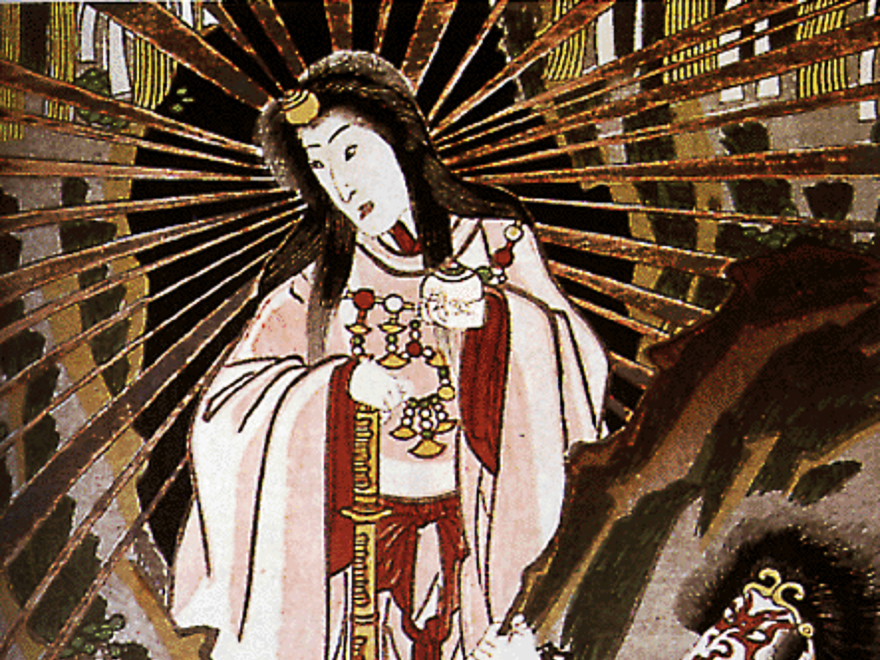 W
WThe Three Sacred Treasures are the imperial regalia of Japan and consist of the sword Kusanagi no Tsurugi (草薙劍), the mirror Yata no Kagami (八咫鏡), and the jewel Yasakani no Magatama (八尺瓊勾玉). They represent the three primary virtues: valour, wisdom, and benevolence.
 W
WThe following is a list of sacred objects in Japanese mythology.
 W
WLondon Stone is a historic landmark housed at 111 Cannon Street in the City of London. It is an irregular block of oolitic limestone measuring 53 × 43 × 30 cm, the remnant of a once much larger object that had stood for many centuries on the south side of the street.
 W
WThe Nanteos Cup is a medieval wood mazer bowl, held for many years at Nanteos Mansion, Rhydyfelin, near Aberystwyth in Wales.
 W
WIn Greek mythology Nestor's Cup is a legendary golden mixing cup which was owned by the hero Nestor. The cup is described in the Iliad, and possibly appeared elsewhere in the Epic Cycle. Despite its brief appearance in the Iliad, the cup was the subject of significant attention from ancient commentators on Homer.
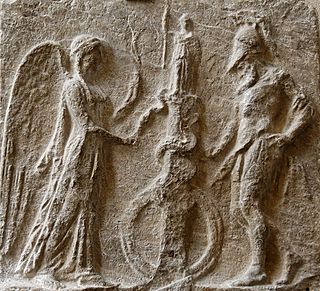 W
WIn Greek and Roman mythology, the Palladium or Palladion was a cult image of great antiquity on which the safety of Troy and later Rome was said to depend, the wooden statue (xoanon) of Pallas Athena that Odysseus and Diomedes stole from the citadel of Troy and which was later taken to the future site of Rome by Aeneas. The Roman story is related in Virgil's Aeneid and other works. Rome possessed an object regarded as the actual Palladium for several centuries; it was in the care of the Vestal Virgins for nearly all this time.
 W
WPandora's box is an artifact in Greek mythology connected with the myth of Pandora in Hesiod's Works and Days. He reported that curiosity led her to open a container left in care of her husband, thus releasing physical and emotional curses upon mankind. Later depictions of the story have been varied, while some literary and artistic treatments have focused more on the contents than on Pandora herself.
 W
WIn medieval and ancient philosophy the Wheel of Fortune, or Rota Fortunae, is a symbol of the capricious nature of Fate. The wheel belongs to the goddess Fortuna who spins it at random, changing the positions of those on the wheel: some suffer great misfortune, others gain windfalls. The metaphor was already a cliché in ancient times, complained about by Tacitus, but was greatly popularized for the Middle Ages by its extended treatment in the Consolation of Philosophy by Boethius from around 520. It became a common image in manuscripts of the book, and then other media, where Fortuna, often blindfolded, turns a large wheel of the sort used in watermills, to which kings and other powerful figures are attached.
 W
WIn Finnish mythology, the Sampo is a magical device or object described in many different ways that was constructed by the blacksmith Ilmarinen and that brought riches and good fortune to its holder. When the Sampo was stolen, Ilmarinen's homeland fell upon hard times. He sent an expedition to retrieve it, but in the ensuing battle it was smashed and lost at sea.
 W
WThe Sessho-seki , or "Killing Stone", is an object in Japanese mythology. It is said that the stone kills anyone who comes into contact with it.
 W
WThe shield of Achilles is the shield that Achilles uses in his fight with Hector, famously described in a passage in Book 18, lines 478–608 of Homer's Iliad. The intricately detailed imagery on the shield has inspired many different interpretations of its significance.
 W
WThe Shield of Aeneas is the shield that Aeneas receives from the god Vulcan in Book VIII of Virgil's Aeneid to aid in his war against the Rutuli. Imprinted on the front of the shield is a grand depiction of the destiny of Aeneas' descendants and the future of Rome.
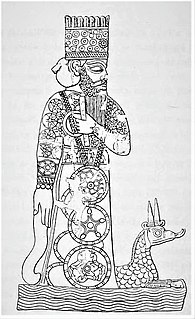 W
WThe Statue of Marduk, also known as the Statue of Bêl, was the physical representation of the god Marduk, the patron deity of the ancient city of Babylon, traditionally housed in the city's main temple, the Esagila. There were seven statues of Marduk in Babylon, but 'the' Statue of Marduk generally refers to the god's main statue, placed prominently in the Esagila and used in the city's rituals. This statue was nicknamed the Asullḫi and was made of a type of wood called mēsu and covered with gold and silver.
 W
WA thyrsus /ˈθɜːrsəs/ or thyrsos /ˈθɜːrˌsɒs/ was a wand or staff of giant fennel covered with ivy vines and leaves, sometimes wound with taeniae and topped with a pine cone or by a bunch of vine-leaves and grapes or ivy-leaves and berries, carried during Hellenic festivals and religious ceremonies. The thyrsus is typically associated with the Greek god Dionysus, or his Roman counterpart Bacchus, and represents a symbol of prosperity, fertility, and hedonism similarly to Dionysus.
 W
WA trident is a three-pronged spear. It is used for spear fishing and historically as a polearm.